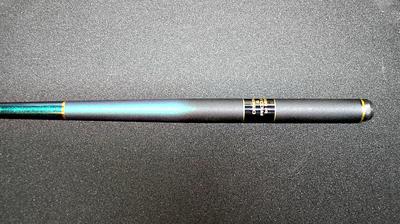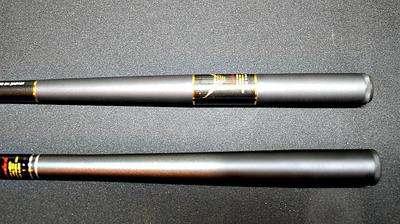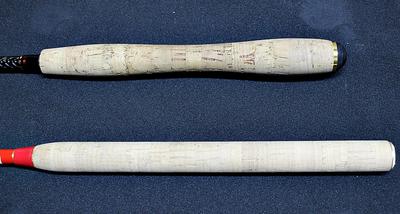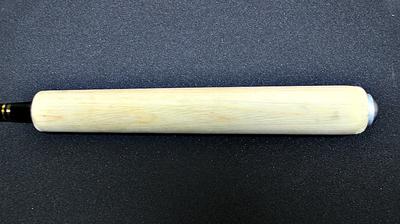A Few Thoughts on Rod Handles
by John Evans
(San Antonio, TX)

The super-slim profile of the non-skid handle perfectly matches the Nissin Air Stage Hakubai 240.
One subject tenkara and keiryu anglers enjoy discussing is the shape and construction of rod handles. In looking over my rod rack, I see that four types of materials are represented: the plain, non-skid surface of rods that are designed for keiryu fishing, the traditional cork handles of tenkara rods, EVA foam that is becoming more common, and wood—which is, perhaps, the least common. Like most anglers, I’ve developed opinions over the past few years, but I’d be interested to know the views of others.
Five thoughts come to mind when I consider past angling experiences, though I recognize that my views may change.
First, a good rod doesn’t have a bad handle. What I’m saying is that the handle is a part of the whole package. I doubt that most tenkara anglers choose a specific rod just because of the grip material or shape. Instead, we consider the other merits of the pole, and the handle is just a part of the buying decision. If the rod works well, then the handle must be doing its job, too. I’ve never said, “Boy, this rod is great, but I just can’t stand the handle”! I would also say that good companies do a fine job of incorporating excellent handle design into their rods. All of the rods that I’ve ordered from Chris Stewart have felt just fine in the hand. And, while I might slightly prefer one handle over another, the differences, even among the various materials, are relatively minor. Frankly, after thousands of casts, I’ve never lost a rod because I couldn’t hang onto it.
Second, the material is often less important than the shape of the handle. Study the photo above of the Suntech Field Master 39 and the Suntech GM Keiryu Special 39. Cosmetically, these rods are quite similar, though the Field Master is a stiffer rod. The handles are the same non-skid surface. But, do you see how the Field Master handle flares slightly more? It gives a different feeling when you hold it. The Keiryu Special is more streamlined, while the Field Master may afford a little better purchase for bigger fish. Both handles, however, work well. Also, the straight cork cylinder of the Tenyru Furiabo has a different feel than the gourd-shaped Nissin Zerosum. Again, both are excellent rods that represent different approaches. All of these handles are pleasing.
Third, companies should match the handle to the rod. The one thing I can’t stand is when a handle seems mismatched to the pole. I’ve never had this problem with any rod that I’ve purchased from TenkaraBum, but I have seen it on bargain-basement rods. Why would you put a clunky grip on a sensitive, small-stream rod? Who would want to fish with that pole for very long? Doesn’t a slim pole that weighs an ounce or less cry out for a streamlined handle that fits it? For example, the super-slim non-skid grip on the Nissin Air Stage Hakubai 240 looks like it grew on that rod naturally. No other handle belongs there!
Fourth, the size of the angler’s hands often influences handle preference. I have an extra-large grip, so it’s not unusual for tenkara handles to feel a little small in diameter for me. Is that the fault of the designers? Of course not! It does mean, however, that I may find larger handles to be a little more comfortable. For example, the wood grip on the Nissin Royal Stage Honryu 330 works especially well for me. I would think that one of the biggest challenges facing rod designers is how to design handles that adequately fit a huge range of anglers from several different countries.
Fifth, all rod handles reflect some compromise. To say it another way, no handle can possibly be perfect in all respects for all anglers. The plain, non-skid surface on keiryu rods is super-sensitive but may not give quite as good a grip as a cork handle. High-quality cork is comfortable and aesthetically pleasing but may not be quite as light or sensitive. EVA foam allows a secure, comfortable purchase but may not be as pretty as cork. A classy wood handle combines a substantial grip with excellent sensitivity but adds a little bit of weight and expense. Decisions on the handle also affect the price of the rod. One of the first give-aways on a cheap rod with a cork handle is the amount of filler in the grip. The first time I compared the super high-quality cork on my Tenryu Furaibo TF39 to an inexpensive pole was a real eye-opener.
Also, tenkara and keiryu rods vary widely in the length of the grip, which affects both the weight and balance point of the pole. Obviously, a two-handed carp rod needs a different handle than a super-light seiryu pole.
I’ll repeat what I said at the beginning, however: If the rod works well, the handle must be doing its job.
So, next time you pick up your tenkara or keiryu rod, give the handle some thought and see if you can discern the designer’s choices. Does the shape and material of the grip fit the overall design of the pole? Would you have done anything differently? I’d like to read of your experiences.
Return to Your Tenkara Stories.
“The bitterness of poor quality remains long after the sweetness of low price is forgotten” - Benjamin Franklin
"Be sure in casting, that your fly fall first into the water, for if the line fall first, it scares or frightens the fish..." -
Col. Robert Venables 1662
As age slows my pace, I will become more like the heron.
Warning:
The hooks are sharp.
The coffee's hot.
The fish are slippery when wet.
Beware of the Dogma
Currently processing orders that were received Mar 8.









